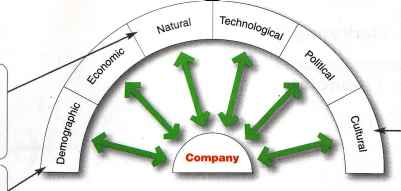Changing Age Structure of the Population
The U.S. population stood at over 302 million in 2007 and may reach almost 364 million by the year 2030.7 The single most important demographic trend in the United States is the changing age structure of the population. The U.S. population contains several generational groups. Here, we discuss the three largest groups— the baby boomers, Generation X, and the Millennials—and their impact on today's marketing strategies.
The Baby Boomers. The post-World War n baby boom produced 78 million baby boomers, born between 1946 and 1964. Over the years, the baby boomers have been one of the most powerful forces shaping the marketing environment.
Demographics and business: Chinese regulations limiting families to one child have resulted in what's known as the "six-pocket syndrome." Chinese children and teens are being showered with attention and luxuries, creating opportunities for marketers.
Major Forces in the Company's Macroenvironment
Concern for the naturai environment has spawned a so-called green movement in industries ranging from PCs to diesel locomotives. As of 2007, for example, HP had recycled 450 million kilograms of electronics globally. The goal of many companies today is environmental sustainability—strategies and practices that the planet can support indefinitely.
Changing demographics mean changes in markets, which In turn require changes in marketing strategies. For example, Amerprise Financial now targets aging baby boomers with the promise that it will help them "envision what exactly you want to do in the next phase of your lite,"

Marketers also want to be socially responsible citizens in their markets and communities. For example, shoe brand TOMS was founded on a cause: "No complicated formulas It's simple," says the company's founder. "You buy a pair of TOMS and I give a pair to a child in need on your behalf."
Today's baby boomers account for nearly 30 percent of the population, spend about $2.3 trillion annually, and hold three-quarters of the nation's financial assets.8
The youngest boomers are now in their mid forties; the oldest are entering their sixties. The maturing boomers are rethinking the purpose and value of their work, responsibilities, and relationships. As they reach their peak earning and spending years, the boomers constitute a lucrative market for financial services, new housing and home remodeling, travel and entertainment, eating out, health and fitness products, and just about everything else.
It would be a mistake to think of the aging boomers as phasing out or slowing down. Today's boomers think young no matter how old they are. In fact, the boomers are spending $30 billion a year on antiagmg products and services. And unlike previous generations, boomers are retiring later and working more after retirement. Rather than viewing themselves as phasing out, they see themselves as entering new life phases. According to one observer:9
The boomers thrive on change and reinvention. They did not grow up with the Internet, but they readily go online to plot out vacations and seek bargains. They grew up with television, but they have embraced TiVo and VCR's and other technologies that let them scoot past commercials. They may not like rap music, but they'll listen to their own music on the same types of iPods that their children use. For example, take Frank Zacherl and his wife Dixie. Frank is a Windows Vista guru. He loves to rip music, post videos on YouTube, and Skype his grandchildren. Frank is 65. His wife, Dixie is an iPod fanatic and fellow Skype user. The older boomers get, it seems, the younger they seem to feel. . . . They see retirement not as an end but as just another stage in life.
Toyota recognizes these changing boomer life phases. Ads for its Toyota Highlander show empty-nest boomers and declare "For your newfound freedom." Similarly, Curves fitness centers targets older women, but not grandmas in rocking chairs. Curves' older regulars "want to be strong and fit," says the expert. "They just don't want to go into Gold's Gym and be surrounded by spandex-clad Barbie dolls."10
Similarly, global cosmetics brands such as Dove, L'Oréal, CoverGirl, and Olay use 50- or 60-something spokespersons such as onetime American supermodel Christie Brinkley and American actress Diane Keaton to appeal to boomer women. And they use sensible, aspirational appeals aimed at confident older consumers who aren't trying to fight the aging process. "Boomers are saying 'I'm aging, but I'm going to do it in a way that's graceful and still about who I am'" says a marketer for Dutch-based Unilever's Dove Pro.Age brand. Says another marketer, "I don't think boomers want to be young again—I don't think they feel old in the first place."11
Perhaps no one is targeting the baby boomers more fervently than the financial services industry. In coming years, the aging boomers will transfer some $30 trillion in retirement nest eggs and other savings into new investments. They'll also be inheriting $8 trillion as their parents pass away. Thus, the boomers will be needing lots of money management help. Says a marketer for Ameriprise (formerly American Express) Financial, "It's not just about the rational numbers. It's about how you are going to reinvent yourself for what could be 30 or 40 years of retirement." An Ameriprise ad promises retiring boomers that the company will "help you envision what exactly you want to do in the next phase of your life."12 (See Real Marketing 3.1.)
Continue reading here: Geographic Shifts in Population
Was this article helpful?
Readers' Questions
-
Vanessa1 month ago
- Reply
-
lois8 months ago
- Reply
